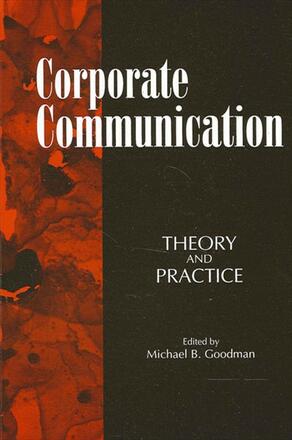Figures and Tables
Preface
Acknowledgments
Chapter 1. Overview: Corporate Communication
What is Corporate Communication, and who does it?
What is the strategic importance of Corporate Communication?
What is Corporate Communication Philosophy?
Further Reading
Chapter 2. Corporate Communication Practice
Overview
Skills and talents for individuals
Small and large group requirements
Presentations: meetings and speeches
Selecting media
SELECTED ESSAYS AND COMMENT
Technological Innovation for Revitalizing Corporate Culture: The Case of Desktop Publishing, Terri Toles-Patkin
CASE STUDIES
Groupware—One Experience, Til Dallavalle, Alicia Esposito, and Steve Lang
Communicating Sudden Change in Tasks and Culture: The Inglis Montmagny Story, Randall Capps
Further Reading
Chapter 3. Corporate Citizenship
Overview
Relations with various publics
Philanthropy programs and policy
Outreach programs
Government relations: local, state, federal regulators and agencies
Customer relations
SELECTED ESSAYS AND COMMENT
Truth and Taste: Revisiting High Ethical Standards for Communicators, William Buchholz
Corporate Language and the Law: Avoiding Liability in Corporate Communications, Kristen R. Woolever
NIMBY: Defining and Dealing with the Not-in-My-Backyard Syndrome, Nancy Blethen
Further Reading
Chapter 4. Corporate Identity
Overview
Mission statements and corporate philosophies
Logos, letterhead, and annual reports
Advertising and company perception
Internal perception programs
External communication and perception of company image
SELECTED ESSAYS AND COMMENT
Using CEOs and Other Amateurs in Corporate Video, Richard Doetkott
High-speed Management: A Revolution in Organizational Communication in the 1990s, Donald P. Cushman
CASE STUDIES
Perspectives on Communicating Corporate Culture to Employee-Owners: A Case Study: Weirton Steel Corporation, Jay Morris
Further Reading
Chapter 5. Corporate Communication and Corporate
Culture Overview
Defining a corporation's culture
Quality programs and corporate culture changes
Diversity and Workforce 2000
Training (Human Resource Development) and perpetuating corporate culture
SELECTED ESSAYS AND COMMENT
Analyzing Corporate Communications Policy Using Ethnographic Methods, Margaret Whitney
Perceptions of Communicative Competence in Organizational Settings: The Influence of Styles and Stereotypes, Ann Bohara and Patrick McLaurin
Sexual Harassment and Immediacy Behaviors in the Multicultural Workplace: A Communication Paradox, Loretta Harper and Lawrence Rifkind
CASE STUDIES
Carnival, Resistance, and Transgression in the Workplace, Jeanne Rogge Steele
Further Reading
Chapter 6. Corporate Communication and Meeting the Press
Overview
Wall Street: the financial press
Main Street: the hometown media
Park Ave. : National newspapers
Industrial Blvd. : the trade publications
Research Plaza: professional journals
Broadway: entertainment media
SELECTED ESSAYS AND COMMENT
Public Relations and Commercial Speech at the Crossroads: Implications for the Pharmaceutical Industry and for the Profession, Dulcie Murdock Straughan
CASE STUDY
Case Study of a Public Affairs Program: TimeMagazine's Environmental Challenge, Nancy VanArsdale
Further Reading
Chapter 7. Corporate Communications and Media
Overview
Broadcast news networks
Public broadcasting and corporate sponsorship
Radio
Cable network
Video and satellite news releases
Voice Mail, E-Mail, and LAN
SELECTED ESSAYS AND COMMENT
Using Corporate Video to Communicate Advanced Technology, Julia A. Longo
CASE STUDIES
Using New Video Technology in External Organizational Communication: A Case Study of the Government Information Channel, Ronnie Bankston and Laura Terlip
Further Reading
Chapter 8. Corporate Communications and Crisis
Overview
Stages of a crisis and the corporate response
Crisis Communication Plans
Responding to pressure groups
SELECTED ESSAYS AND COMMENT
Crisis Communication: Knowing How is Good: Knowing Why is Essential, David L. Sturges, et al.
Further Reading
Chapter 9. Corporate Communication in Global Markets
Overview
Communication in the new Europe
Communication and the Pacific Rim
Communication with developing countries
SELECTED ESSAYS AND COMMENT
They Speak English But. . . : The United Kingdom as a Foreign Country, Nicholas D. J. Baldwin
The Politics of Broadcasting in the European Community: The Television without Frontiers Directive, Mitch Baranowski
Further Reading
Contributors
Name Index
Subject Index
